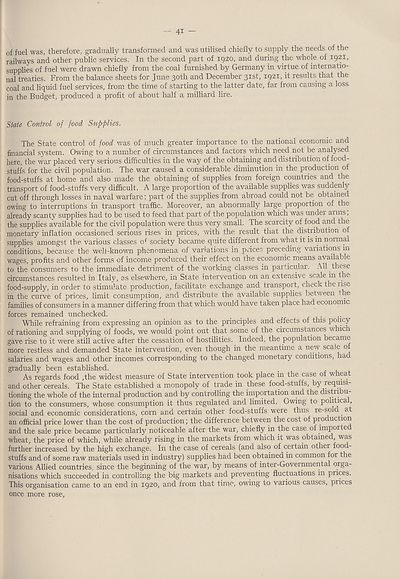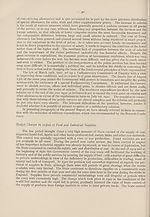Economic and financial section > Brussels Financial Conference 1920 : the recommendations and their application : a review after two years. Vol. 2, Italy
(43)
Download files
Complete book:
Individual page:
Thumbnail gallery: Grid view | List view

4i —
of fuel was, therefore, gradually transformed and was utilised chiefly to supply the needs of the
railways and other public services. In the second part of 1920, and during the whole of 1921,
supplies of fuel were drawn chiefly from the coal furnished by Germany in virtue of internatio¬
nal treaties. From the balance sheets for June 30th and December 31st, 1921, it results that the
coal and liquid fuel services, from the time of starting to the latter date, far from causing a loss
in the Budget, produced a profit of about half a milliard lire.
State Control of food Supplies.
The State control of food was of much greater importance to the national economic and
financial system. Owing to a number of circumstances and factors which need not be analysed
here, the war placed very serious difficulties in the way of the obtaining and distribution of food¬
stuffs for the civil population. The war caused a considerable diminution in the production of
food-stuffs at home and also made the obtaining of supplies from foreign countries and the
transport of food-stuffs very difficult. A large proportion of the available supplies was suddenly
cut off through losses in naval warfare; part of the supplies from abroad could not be obtained
owing to interruptions in transport traffic. Moreover, an abnormally large propoition 01 the
already scanty supplies had to be used to feed that part of the population which was undei aims,
the supplies available for the civil population were thus very small. The scarcity of food and the
monetary inflation occasioned serious rises in prices, with the result that the distribution of
supplies amongst the various classes of society became quite different from what it is in normal
conditions, because the well-known phenomena of variations in prices preceding variations in
wages, profits and other forms of income produced their effect on the economic means available
to the consumers to the immediate detriment of the working classes in particular. All these
circumstances resulted in Italy, os elsewhere, in State intervention on an extensive scale in the
food-supply, in order to stimulate production, facilitate exchange and transport, check theixse
in the curve of prices, limit consumption, and distribute the available supplies between the
families of consumers in a manner differing from that which would have taken place had economic
forces remained unchecked.
While refraining from expressing an opinion as to the principles and effects of this policy
of rationing and supplying of foods, we would point out that some of the circumstances which
gave rise to it were still active after the cessation of hostilities. Indeed, the population oecame
more restless and demanded State intervention, even though in the meantime a new scale o
salaries and wages and other incomes corresponding to the changed monetary conditions, a
gradually been established.
As regards food ,the widest measure of State intervention took place in the^case of whea
and other cereals. The State established a monopoly 01 trade in these food-stuifs, by requisi
tioning the whole of the internal production and by controlling the importation and the distribu¬
tion to the consumers, whose consumption it thus regulated and limited. Owing to pohtiea ,
social and economic considerations, corn and certain other food-stuffs were thus re-so at
an official price lower than the cost of production; the difference between the cost of pro uction
and the sale price became particularly noticeable after the war, chiefly in the case of importe
wheat, the price of which, while already rising in the markets from which it was obtained, Wa.s
further increased by the high exchange. In the case of cereals (and also of certain other food¬
stuffs and of some raw materials used in industry) supplies had been obtained in common for the
various Allied countries, since the beginning of the war, by means of inter-Governmental orga¬
nisations which succeeded in controlling the big markets and preventing fluctuations m prices.
This organisation came to an end in 1920, and from that time, owing to various causes, pi ices
once more rose,
of fuel was, therefore, gradually transformed and was utilised chiefly to supply the needs of the
railways and other public services. In the second part of 1920, and during the whole of 1921,
supplies of fuel were drawn chiefly from the coal furnished by Germany in virtue of internatio¬
nal treaties. From the balance sheets for June 30th and December 31st, 1921, it results that the
coal and liquid fuel services, from the time of starting to the latter date, far from causing a loss
in the Budget, produced a profit of about half a milliard lire.
State Control of food Supplies.
The State control of food was of much greater importance to the national economic and
financial system. Owing to a number of circumstances and factors which need not be analysed
here, the war placed very serious difficulties in the way of the obtaining and distribution of food¬
stuffs for the civil population. The war caused a considerable diminution in the production of
food-stuffs at home and also made the obtaining of supplies from foreign countries and the
transport of food-stuffs very difficult. A large proportion of the available supplies was suddenly
cut off through losses in naval warfare; part of the supplies from abroad could not be obtained
owing to interruptions in transport traffic. Moreover, an abnormally large propoition 01 the
already scanty supplies had to be used to feed that part of the population which was undei aims,
the supplies available for the civil population were thus very small. The scarcity of food and the
monetary inflation occasioned serious rises in prices, with the result that the distribution of
supplies amongst the various classes of society became quite different from what it is in normal
conditions, because the well-known phenomena of variations in prices preceding variations in
wages, profits and other forms of income produced their effect on the economic means available
to the consumers to the immediate detriment of the working classes in particular. All these
circumstances resulted in Italy, os elsewhere, in State intervention on an extensive scale in the
food-supply, in order to stimulate production, facilitate exchange and transport, check theixse
in the curve of prices, limit consumption, and distribute the available supplies between the
families of consumers in a manner differing from that which would have taken place had economic
forces remained unchecked.
While refraining from expressing an opinion as to the principles and effects of this policy
of rationing and supplying of foods, we would point out that some of the circumstances which
gave rise to it were still active after the cessation of hostilities. Indeed, the population oecame
more restless and demanded State intervention, even though in the meantime a new scale o
salaries and wages and other incomes corresponding to the changed monetary conditions, a
gradually been established.
As regards food ,the widest measure of State intervention took place in the^case of whea
and other cereals. The State established a monopoly 01 trade in these food-stuifs, by requisi
tioning the whole of the internal production and by controlling the importation and the distribu¬
tion to the consumers, whose consumption it thus regulated and limited. Owing to pohtiea ,
social and economic considerations, corn and certain other food-stuffs were thus re-so at
an official price lower than the cost of production; the difference between the cost of pro uction
and the sale price became particularly noticeable after the war, chiefly in the case of importe
wheat, the price of which, while already rising in the markets from which it was obtained, Wa.s
further increased by the high exchange. In the case of cereals (and also of certain other food¬
stuffs and of some raw materials used in industry) supplies had been obtained in common for the
various Allied countries, since the beginning of the war, by means of inter-Governmental orga¬
nisations which succeeded in controlling the big markets and preventing fluctuations m prices.
This organisation came to an end in 1920, and from that time, owing to various causes, pi ices
once more rose,
Set display mode to:
![]() Universal Viewer |
Universal Viewer | ![]() Mirador |
Large image | Transcription
Mirador |
Large image | Transcription
Images and transcriptions on this page, including medium image downloads, may be used under the Creative Commons Attribution 4.0 International Licence unless otherwise stated. ![]()
| League of Nations > Economic and financial section > Brussels Financial Conference 1920 : the recommendations and their application : a review after two years. Vol. 2, Italy > (43) |
|---|
| Permanent URL | https://digital.nls.uk/191783481 |
|---|
| Shelfmark | LN.II |
|---|
| Description | Over 1,200 documents from the non-political organs of the League of Nations that dealt with health, disarmament, economic and financial matters for the duration of the League (1919-1945). Also online are statistical bulletins, essential facts, and an overview of the League by the first Secretary General, Sir Eric Drummond. These items are part of the Official Publications collection at the National Library of Scotland. |
|---|---|
| Additional NLS resources: |
|

